List of mammals of Oregon

This list of mammals of Oregon includes all wild mammal species living in or recently extirpated from the U.S. state of Oregon or its coastal shores. This list includes all species from the lists published by the American Society of Mammalogists or found in the comprehensive text Land Mammals of Oregon published in 1998. Rare instances where these lists disagree are noted. Species are grouped by order and then listed in sortable tables by family. Subspecies present in the region are discussed in the notes. The IUCN Red List status for each species is presented. Images presented are from Oregon or adjacent states, as possible. Species found only in captivity are not listed.[1][2]
Oregon mammals by order
Table has not been updated for threatened species, thus all are listed "n/a".
| Order | Members | Species | Threatened species |
|---|---|---|---|
| Artiodactyla | Even-toed ungulates | 7 | n/a |
| Carnivora | Carnivorans | 24 | n/a |
| Cetacea | Whales, dolphins and porpoises | 6 | n/a |
| Chiroptera | Bats | 15 | n/a |
| Didelphimorphia | Common opossums | 1 | n/a |
| Lagomorpha | Hares, rabbits and pikas | 8 | n/a |
| Rodentia | Rodents | 63 | n/a |
| Soricomorpha | Shrews, moles and solenodons | 15 | n/a |
| Total | 139 | n/a | |
Conservation statuses
Species are classified in nine groups, set through criteria such as rate of decline, population size, area of geographic distribution, degree of population and distribution fragmentation. The tables below reclassified results before 1994 to reflect the current rating system.
| Low vulnerability | Threatened | Extinct | Insufficient data | |||||||||||||||||||||
|---|---|---|---|---|---|---|---|---|---|---|---|---|---|---|---|---|---|---|---|---|---|---|---|---|
|
|
|
|
Terrestrial mammals
Carnivora

Carnivora (/kɑːrˈnɪvərə/ or /ˌkɑːrnɪˈvɔːrə/; from Latin carō (stem carn-) "flesh", + vorāre "to devour") is one of the most diverse of the mammalian orders. The gray wolf has recolonized Oregon especially in the northeast and is included in the list below. The grizzly bear was extirpated from the state in approximately 1940. Since it is included in Land Mammals of Oregon, it is included in the list below.[4]
| Common name | Scientific name authority |
Family | Distribution and notes[1] | Red List |
|---|---|---|---|---|
Coyote
|
Canis latrans (Say, 1823) |
Canidae | Intermediate size between foxes and wolf; albinos have been documented in state; two of nineteen geographic races are known in the state.[5] | |
Gray wolf
|
Canis lupus (Linnaeus, 1758) |
Canidae | Resettled in the state. Gray wolves in Oregon represent northwestern wolves (Canis lupus occidentalis) which migrated from neighboring Idaho; as of the end of 2013, there were a minimum 64 individuals with 4 breeding pairs.[7] Protected under the state Endangered Species Act and under the federal ESA west of highways.[8] The first confirmed wolf in the state since 1947 was OR-7 (pictured), also known as Journey. | |
Gray fox |
Urocyon cinereoargenteus (Schreber, 1775) |
Canidae | Found throughout the state; grizzle gray coloring; tail has black stripe on dorsal aspect; nocturnal and crepuscular; tree climber for resting, foraging or escape from predators (unique among North American canids)[10] | |
Kit fox |
Vulpes macrotis (Merriam, 1888) |
Canidae | Southeast region of state; smallest canid in North America; brownish-gray dorsum, lightening through buff to white on abdomen; large ears; tip of tail is black.[10] | |
Red fox |
Vulpes vulpes (Linnaeus, 1758) |
Canidae | Found throughout state; red phase individuals are more predominant than silver or crossed; populations increased as wolf populations declined; subspecies Sierra Nevada red fox (Vulpes vulpes necator) observed on Mt Hood and Crater Lake in or after 2010.[13] | |
Black bear |
Ursus americanus (Pallas, 1780) |
Ursidae | ||
Grizzly bear |
Ursus arctos (Linnaeus, 1758) |
Ursidae | Extirpated; historically, they were broadly distributed throughout state except for arid eastern reaches. The last grizzly was killed in Oregon in 1931, according to some authorities.[15] | |
Wolverine |
Gulo gulo | Mustelidae | Extirpated; occasional vagrants appear from neighboring states. | |
Pacific marten |
Martes caurina (Merriam, 1890) |
Mustelidae | ||
American ermine
|
Mustela richardsonii | Mustelidae | ||
Long-tailed weasel |
Neogale frenata | Mustelidae | ||
American mink |
Neogale vison | Mustelidae | ||
Fisher |
Pekania pennanti (Erxleben, 1777) |
Mustelidae | Reintroduced; protected in Oregon.[16] | |
American badger |
Taxidea taxus | Mustelidae | More common in sagebrush deserts in eastern Oregon. | |
Sea otter |
Enhydra lutris | Mustelidae | Extirpated; the last native sea otter in Oregon was killed in the early 20th century. In 1970 and 1971, 95 sea otters were reintroduced from Amchitka Island, Alaska, to the southern Oregon coast. However, the attempt failed and otters soon disappeared. Occasional sightings are most likely wanderers from neighboring states. | |
North American river otter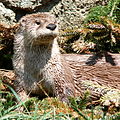 |
Lontra canadensis | Mustelidae | ||
Striped skunk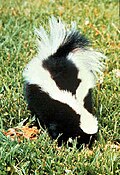 |
Mephitis mephitis | Mephitidae | ||
Western spotted skunk |
Spilogale gracilis | Mephitidae | ||
Northern fur seal |
Callorhinus ursinus | Otariidae | ||
Steller sea lion |
Eumetopias jubatus | Otariidae | ||
Harbor seal |
Phoca vitulina | Phocidae | ||
Northern elephant seal |
Mirounga angustirostris | Phocidae | ||
Ring-tailed cat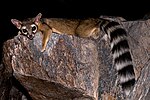 |
Bassariscus astutus | Procyonidae | ||
Raccoon |
Procyon lotor | Procyonidae | ||
Canada lynx |
Lynx canadensis | Felidae | Extirpated; historically ranged through the Willamette Valley, the Cascade range, Steens Mountain, the Stinkingwater Mountains, the Blue Mountains and the Wallowa Mountains.[17] Under federal ESA protection since 2000 with critical habitat areas defined.[18] | |
Bobcat |
Lynx rufus | Felidae | ||
Mountain lion |
Puma concolor | Felidae |
Chiroptera

| Common name | Scientific name authority |
Family | Distribution and notes[1] | Red List |
|---|---|---|---|---|
Big brown bat |
Eptesicus fuscus | Vespertilionidae | ||
Western pipistrelle or canyon bat
|
Pipistrellius hesperus | Vespertilionidae | Smallest bat in Oregon.[20] | |
Western red bat |
Lasiurus blossevillii | Vespertilionidae | ||
Hoary bat |
Lasiurus cinereus | Vespertilionidae | ||
Townsend's big-eared bat |
Corynorhinus townsendii | Vespertilionidae | ||
Spotted bat |
Euderma maculatum | Vespertilionidae | ||
Pallid bat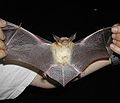 |
Antrozous pallidus | Vespertilionidae | Typically found in desert regions, semi-arid.[1] | |
Silver-haired bat |
Lasionycteris noctivagans | Vespertilionidae | ||
Californian myotis |
Myotis californicus | Vespertilionidae | ||
Western small-footed bat |
Myotis ciliolabrum | Vespertilionidae | ||
Little brown myotis |
Myotis lucifugus | Vespertilionidae | ||
Dark-nosed small-footed myotis |
Myotis melanorhinus | Vespertilionidae | ||
Fringed myotis |
Myotis thysanodes | Vespertilionidae | ||
Long-legged myotis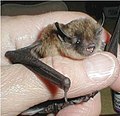 |
Myotis volans | Vespertilionidae | ||
Yuma myotis |
Myotis yumanensis | Vespertilionidae | ||
Brazilian/Mexican free-tailed bat |
Tadarida brasiliensis | Molossidae |
Rodentia

The North Oregon Coast population of red tree voles (Arborimus longicaudus) are candidates for protection under the Endangered Species Act.[23][24]
| Common name | Scientific name authority |
Family | Distribution and notes[1] | Red List |
|---|---|---|---|---|
Mountain beaver |
Aplodontia rufa | Aplodontidae | ||
North American beaver |
Castor canadensis | Castoridae | ||
Common porcupine |
Erethizon dorsatum | Erethizontidae | ||
Nutria |
Myocastor coypus | Myocastoridae | Introduced. | |
Long-tailed vole |
Microtus longicaudus | Cricetidae | ||
| Montane vole |
Microtus montanus | Cricetidae | ||
Creeping vole |
Microtus oregoni | Cricetidae | ||
| North American water vole |
Microtus richardsoni | Cricetidae | ||
Townsend's vole |
Microtus townsendii | Cricetidae | ||
Bushy-tailed woodrat |
Neotoma cinerea | Cricetidae | ||
Dusky-footed woodrat |
Neotoma fuscipes | Cricetidae | ||
| Desert woodrat |
Neotoma lepida | Cricetidae | ||
Common muskrat |
Ondatra zibethicus | Cricetidae | ||
Northern grasshopper mouse
|
Onychomys leucogaster | Cricetidae | ||
| White-footed vole |
Arborimus albipes | Cricetidae | ||
Red tree vole
|
Arborimus longicaudus | Cricetidae | ||
Western red-backed vole
|
Clethrionomys californicus | Cricetidae | ||
Southern red-backed vole
|
Myodes gapperi | Cricetidae | ||
| Sagebrush vole |
Lemmiscus curtatus | Cricetidae | ||
California vole
|
Microtus californicus | Cricetidae | ||
| Gray-tailed vole |
Microtus canicaudus | Cricetidae | ||
| Brush deermouse |
Peromyscus boylii | Cricetidae | ||
| Canyon deermouse |
Peromyscus crinitus | Cricetidae | ||
Western deermouse
|
Peromyscus sonoriensis | Cricetidae | ||
Piñon deermouse
|
Peromyscus truei | Cricetidae | ||
| Western heather vole |
Phenacomys intermedius | Cricetidae | ||
Western harvest mouse
|
Reithrodontomys megalotis | Cricetidae | ||
Botta's pocket gopher
|
Thomomys bottae | Geomyidae | ||
Northern pocket gopher
|
Thomomys talpoides | Geomyidae | ||
Mazama pocket gopher
|
Thomomys mazama | Geomyidae | ||
| Townsend's pocket gopher |
Thomomys townsendii | Geomyidae | ||
Camas pocket gopher
|
Thomomys bulbivorus | Geomyidae | ||
| California kangaroo rat |
Dipodomys californicus | Heteromyidae | ||
Yellow-pine chipmunk
|
Tamias amoenus | Sciuridae | ||
Least chipmunk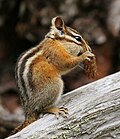
|
Tamias minimus | Sciuridae | ||
North American red squirrel
|
Tamiasciurus hudsonicus | Sciuridae | ||
Belding's ground squirrel
|
Urocitellus beldingi | Sciuridae | ||
| Merriam's ground squirrel |
Urocitellus canus | Sciuridae | ||
Columbian ground squirrel
|
Urocitellus columbianus | Sciuridae | ||
Wyoming ground squirrel
|
Urocitellus elegans | Sciuridae | ||
Chisel-toothed kangaroo rat
|
Dipodomys microps | Heteromyidae | ||
Ord's kangaroo rat
|
Dipodomys ordii | Heteromyidae | ||
| Dark kangaroo mouse |
Microdipodops megacephalus | Heteromyidae | ||
Little pocket mouse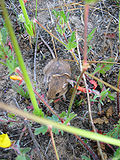
|
Perognathus longimembris | Heteromyidae | ||
| Great Basin pocket mouse |
Perognathus parvus | Heteromyidae | ||
House mouse
|
Mus musculus | Muridae | Not native | |
Brown rat
|
Rattus norvegicus | Muridae | Not native | |
Black rat
|
Rattus rattus | Muridae | Not native | |
Golden-mantled ground squirrel
|
Callospermophilus lateralis | Sciuridae | ||
Douglas squirrel
|
Tamiasciurus douglasii | Sciuridae | ||
Northern flying squirrel
|
Glaucomys sabrinus | Sciuridae | ||
| Humboldt's flying squirrel |
Glaucomys oregonensis | Sciuridae | ||
Yellow-bellied marmot
|
Marmota flaviventris | Sciuridae |
Artiodactyla

| Common name | Scientific name authority |
Family | Distribution and notes[1] | Red List |
|---|---|---|---|---|
Elk |
Cervus canadensis | Cervidae | Common throughout state | |
Mule deer
|
Odocoileus hemionus | Cervidae | Common throughout | |
White-tailed deer
|
Odocoileus virginianus | Cervidae | Common throughout | |
Moose
|
Alces americanus | Cervidae | Northeastern reaches, Wallowa County, small herd of the subspecies Shiras moose (A. a. shirasi);[32] largest extant species in deer family; herbivorous. | |
Pronghorn antelope
|
Antilocapra americana | Antilocapridae | The Oregon pronghorn subspecies (A. a. oregona Bailey) has been described, but taxonomic status may be in question. Found in sagebrush steppe in eastern regions of state. Fastest mammal on the continent: top speeds of 50 mph (80 km/hr)[34] (Image taken in Catlow Valley, Oregon) |
|
Bighorn sheep
|
Ovis canadensis | Bovidae | Historically native to much of eastern Oregon, but then became extinct in the state[35] until reintroductions, recently to the Mutton Mountains,[36] Cottonwood Canyon State Park and near the John Day Fossil Beds in the 21st century;[37] bighorn sheep now live in herds scattered across eastern Oregon.[35] | |
Mountain goat
|
Oreamnos americanus | Bovidae | Historically native to the northern Oregon Cascades and the Wallowa and Blue mountains until extinction in the state in the 19th or 20th century; reintroduced to the Wallowa and Elkhorn mountains starting in the 20th century,[35] and recently introduced to Mount Jefferson in 2010 and 2012.[36] (Image is of a young goat in the Elkhorn Mountains.) |
|
American bison
|
Bison bison | Bovidae | Historically native to eastern and central Oregon. Extirpated by the early to mid-19th century. |
Eulipotyphla
| Common name | Scientific name authority |
Family | Distribution and notes[1] | Red List |
|---|---|---|---|---|
Baird's shrew |
Sorex bairdii | Soricidae | Endemic to northwestern Oregon; two subspecies described, see main article page; dwells among conifers. | |
Marsh shrew |
Sorex bendirii | Soricidae | ||
Masked shrew |
Sorex cinereus | Soricidae | Disputed. On ASM list but not in Verts. | |
| Merriam's shrew | Sorex merriami | Soricidae | ||
| Dusky shrew | Sorex monticolus | Soricidae | ||
| Pacific shrew | Sorex pacificus | Soricidae | ||
American water shrew |
Sorex palustris | Soricidae | ||
| Preble's shrew | Sorex preblei | Soricidae | ||
| Fog shrew | Sorex sonomae | Soricidae | ||
| Trowbridge's shrew | Sorex trowbridgii | Soricidae | ||
| Vagrant shrew | Sorex vagrans | Soricidae | ||
Shrew mole |
Neurotrichus gibbsii | Talpidae | ||
Broad-footed mole |
Scapanus latimanus | Talpidae | ||
| Coast mole | Scapanus orarius | Talpidae | ||
Townsend's mole |
Scapanus townsendii | Talpidae |
Lagomorpha
The order Lagomorpha consists of two living families: the Leporidae (hares and rabbits) and the Ochotonidae (pikas). The name of the order is derived from the Greek lagos (λαγός, "hare") and morphē (μορφή, "form"). There are eight species in Oregon.[39]
| Common name | Scientific name authority |
Family | Distribution and notes[1] | Red List |
|---|---|---|---|---|
American pika |
Ochotona princeps (Richardson, 1828) |
Ochotonidae | Columbia River Gorge, western Cascades; common herbivore; lives in rocky areas/talus habitat near vegetation, meadows; lava flows, woodcuts, disturbed habitat. | |
Pygmy rabbit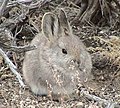 |
Brachylagus idahoensis (Merriam, 1891) |
Leporidae | Southern Oregon, endangered in Washington; resides among dense sagebrush; rarely daytime; mostly active dawn/dusk (crepuscular); burrow dwellings; walks/scurries. | |
Snowshoe hare |
Lepus americanus | Leporidae | Northern coast, south-central, and eastern reaches; shelters daytime; vegetation/groundcover; active crepuscular and at night; marshes, forests, dense vegetation habitats. Lepus americanus oregonus subspecies described (Orr)[42] | |
Black-tailed jackrabbit |
Lepus californicus | Leporidae | Southwestern Oregon; agricultural fields, grazing areas/pastures, sagebrush, prairies, deserts; rests in shady ground depressions daytime; active night/crepuscular; lighter markings in summer. | |
White-tailed jackrabbit |
Lepus townsendii | Leporidae | Eastern/central; fields, grasslands, meadows; sometimes sagebrush flats; primary activity nights; characteristic zigzag pattern with rapid bursts and leaps when pursued. | |
Eastern cottontail |
Sylvilagus floridanus | Leporidae | Eastern slopes of the Willamette Valley and the Cascades;[46] near forests, agricultural sites, prairies, wet lowlands, margins of hardwood forests; most common of genus in state; sleeps days, under vegetation; crepuscular to nocturnal. | |
Mountain cottontail |
Sylvilagus nuttallii | Leporidae | East of the Cascades; near rivers/streams, rockier areas; found near spruce and ponderosa pine forests, some sagebrush flats; crepuscular; may climbs trees; eats cheatgrass. | |
Brush rabbit |
Sylvilagus bachmani | Leporidae | Verts, page 131 |
Didelphimorphia
There is only one species from the order Didelphimorphia in the state.
| Common name | Scientific name authority |
Family | Distribution and notes | Red List |
|---|---|---|---|---|
Virginia opossum |
Didelphis virginiana (Kerr, 1792) |
Didelphidae | Introduced early 1900s; adverse impacts on native bird populations from nest disturbances and egg consumption.[50] |
Marine mammals
Cetacea

| Common name | Scientific name authority |
Family | Distribution and notes | Red List |
|---|---|---|---|---|
| Common minke whale |
Balaenoptera acutorostrata | Balaenopteridae | ||
Sei whale
|
Balaenoptera borealis | Balaenopteridae | ||
Blue whale
|
Balaenoptera musculus | Balaenopteridae | ||
Fin whale
|
Balaenoptera physalus | Balaenopteridae | ||
Humpback whale
|
Megaptera novaeangliae | Balaenopteridae | ||
Gray whale
|
Eschrichtius robustus | Eschrichtiidae | ||
Short-beaked common dolphin
|
Delphinus delphis | Delphinidae | ||
| Short-finned pilot whale |
Globicephala macrorhynchus | Delphinidae | ||
Risso's dolphin
|
Grampus griseus | Delphinidae | ||
Pacific white-sided dolphin
|
Lagernorhynchus obliquidens | Delphinidae | ||
Northern right whale dolphin
|
Lissodelphis borealis | Delphinidae | ||
Killer whale
|
Orcinus orca | Delphinidae | ||
False killer whale
|
Pseudorca crassidens | Delphinidae | ||
Striped dolphin
|
Stenella coeruleoalba | Delphinidae | ||
Harbor porpoise
|
Phocoena phocoena | Phocoenidae | ||
Dall's porpoise
|
Phocoenoides dalli | Phocoenidae | ||
Sperm whale
|
Physeter macrocephalus | Physeteridae | ||
| Pygmy sperm whale |
Kogia breviceps | Kogiidae | ||
Dwarf sperm whale
|
Kogia sima | Kogiidae | ||
| Baird's beaked whale |
Berardius bairdii | Ziphiidae | ||
| Hubbs' beaked whale |
Mesoplodon carlhubbsi | Ziphiidae | ||
Stejneger's beaked whale
|
Mesoplodon stejnegeri | Ziphiidae | ||
Cuvier's beaked whale
|
Ziphius cavirostris | Ziphiidae |
See also
- Fauna of Oregon
- List of prehistoric mammals
- Lists of mammals by region
- Mammal classification
- List of mammals described in the 2000s
References
- ^ a b c d e f g h "Mammals of Oregon". American Society of Mammalogists. Archived from the original on December 19, 2012. Retrieved October 18, 2014.
- ^ VertsCarraway 1998
- ^ "Black Bears". Oregon Department of Fish and Wildlife. Oregon Department of Fish and Wildlife. Retrieved October 26, 2014.
- ^ VertsCarraway 1998, p. 378
- ^ VertsCarraway 1998, pp. 355–356
- ^ Kays, R. (2018). "Canis latrans". IUCN Red List of Threatened Species. 2018: e.T3745A163508579. doi:10.2305/IUCN.UK.2018-2.RLTS.T3745A163508579.en. Retrieved November 12, 2021.
- ^ "ODFW Gray Wolf Population". Retrieved October 21, 2014.
- ^ "ODFW Threatened, Endangered, and Candidate Fish and Wildlife Species". Retrieved October 26, 2014.
- ^ Boitani, L.; Phillips, M.; Jhala, Y. (2018). "Canis lupus". IUCN Red List of Threatened Species. 2018: e.T3746A163508960. doi:10.2305/IUCN.UK.2018-2.RLTS.T3746A163508960.en. Retrieved November 12, 2021.
- ^ a b VertsCarraway 1998, p. 366
- ^ Roemer, G.; Cypher, B.; List, R. (2016). "Urocyon cinereoargenteus". IUCN Red List of Threatened Species. 2016: e.T22780A46178068. doi:10.2305/IUCN.UK.2016-1.RLTS.T22780A46178068.en. Retrieved November 12, 2021.
- ^ Cypher, B.; List, R. (2014). "Vulpes macrotis". IUCN Red List of Threatened Species. 2014: e.T41587A62259374. doi:10.2305/IUCN.UK.2014-3.RLTS.T41587A62259374.en. Retrieved November 12, 2021. Database entry includes a brief justification of why this species is of least concern
- ^ Carolyn Jones (June 20, 2012). "Threatened California fox species found in Oregon". San Francisco Chronicle. Retrieved July 7, 2012.
- ^ Hoffmann, M.; Sillero-Zubiri, C. (2021). "Vulpes vulpes". IUCN Red List of Threatened Species. 2021: e.T23062A193903628. doi:10.2305/IUCN.UK.2021-1.RLTS.T23062A193903628.en. Retrieved November 12, 2021.
- ^ David Maehr; Reed F. Noss; Jeffery L. Larkin (October 1, 2001). Large Mammal Restoration: Ecological And Sociological Challenges In The 21st Century. Island Press. pp. 29–. ISBN 978-1-55963-817-3.
- ^ Ruggiero, technical editors, Leonard F.; et al. (1994). The Scientific basis for conserving forest carnivores : American marten, fisher, lynx and wolverine in the western United States. Fort Collins, Colorado: U.S. Department of Agriculture, Forest Service, Rocky Mountain forest and range experiment station. p. 40. ISBN 0788136283. Retrieved October 21, 2014.
{{cite book}}:|first1=has generic name (help)CS1 maint: multiple names: authors list (link) - ^ "ODFW, Oregon Wildlife Species: Cats". Retrieved October 26, 2014.
- ^ a b Vashon, J. (2016). "Lynx canadensis". IUCN Red List of Threatened Species. 2016: e.T12518A101138963. doi:10.2305/IUCN.UK.2016-2.RLTS.T12518A101138963.en. Retrieved November 12, 2021.
- ^ "ODFW News".
- ^ VertsCarraway 1998, p. 105
- ^ Solari, S. (2019). "Parastrellus hesperus". IUCN Red List of Threatened Species. 2019: e.T17341A22129352. doi:10.2305/IUCN.UK.2019-1.RLTS.T17341A22129352.en. Retrieved November 12, 2021.
- ^ Arroyo-Cabrales, J.; de Grammont, P.C. (2017). "Antrozous pallidus". IUCN Red List of Threatened Species. 2017: e.T1790A22129152. doi:10.2305/IUCN.UK.2017-2.RLTS.T1790A22129152.en. Retrieved November 12, 2021.
- ^ a b "Species Fact Sheet Red tree vole Arborimus longicaudus". ODFW. Oregon Department of Fish and Wildlife. Retrieved October 19, 2014.
- ^ "USFWS Arborimus longicaudus Listing Status: Candidate". US Fish & Wildlife Service. U.S. Department of Interior, Fish and Wildlife Service. Retrieved October 19, 2014.
- ^ Linzey, A.V.; Hammerson, G. (2008). "Microtus oregoni". IUCN Red List of Threatened Species. 2008. Retrieved October 26, 2014.
- ^ Linzey, A.V.; Hammerson, G. (2008). "Microtus richardsoni". IUCN Red List of Threatened Species. 2008. Retrieved October 26, 2014.
- ^ Linzey, A.V.; NatureServe (Hammerson, G.) (2008). "Microtus townsendii". IUCN Red List of Threatened Species. 2008. Retrieved October 26, 2014.
- ^ Linzey, A.V.; NatureServe (Hammerson, G.) (2008). "Neotoma cinerea". IUCN Red List of Threatened Species. 2008. Retrieved October 26, 2014.
- ^ Cassola, F. (2016). "Neotoma fuscipes". IUCN Red List of Threatened Species. 2016: e.T14587A22371665. doi:10.2305/IUCN.UK.2016-2.RLTS.T14587A22371665.en. Retrieved November 12, 2021.
- ^ Linzey, A.V.; Timm, R.; Álvarez-Castañeda, S.T.; Castro-Arellano, I.; Lacher, T. (2008). "Neotoma lepida". IUCN Red List of Threatened Species. 2008. Retrieved February 4, 2010.
- ^ Cassola, F. (2016). "Ondatra zibethicus". IUCN Red List of Threatened Species. 2016: e.T15324A22344525. doi:10.2305/IUCN.UK.2016-3.RLTS.T15324A22344525.en. Retrieved November 12, 2021.
- ^ Cockle, Richard (January 17, 2010). "Oregon Biologists Fear Small Moose Herd May Be Infected with Deadly Parasite". The Oregonian. Portland: Oregon Live. Retrieved October 26, 2014.
- ^ Geist, V.; Ferguson, M.; Rachlow, J (2008). "Alces americanus". IUCN Red List of Threatened Species. 2008. Retrieved October 19, 2014.
- ^ "Wildlife Species: Antilocapra americana". US Forest Service. Retrieved October 30, 2014.
- ^ a b c "Oregon's Bighorn Sheep and Rocky Mountain Goat Management Plan" (PDF). Oregon Department of Fish and Wildlife. December 2003. pp. i, 1, 23–24. Retrieved October 26, 2014.
- ^ a b "Oregon mountain goats coming back". The Columbian. Vancouver, Washington. Associated Press. December 26, 2012. Retrieved October 26, 2014.
- ^ Profita, Cassandra (December 17, 2010). "Bighorn sheep released in two new Oregon spots". Oregon Public Broadcasting. Retrieved October 26, 2014.
- ^ Cassola, F. (2016). "Sorex bairdi". IUCN Red List of Threatened Species. 2016: e.T41387A22314464. doi:10.2305/IUCN.UK.2016-2.RLTS.T41387A22314464.en. Retrieved November 12, 2021.
- ^ VertsCarraway 1998, p. x
- ^ Smith, A.T. and Beever, E. (2016). "Ochotona princeps". IUCN Red List of Threatened Species. 2016: e.T41267A45184315. doi:10.2305/IUCN.UK.2016-3.RLTS.T41267A45184315.en. Retrieved November 12, 2021.
{{cite journal}}: CS1 maint: multiple names: authors list (link) - ^ Rachlow, J.; Becker, P.A.; Shipley, L. (2016). "Brachylagus idahoensis". IUCN Red List of Threatened Species. 2016: e.T2963A45176206. doi:10.2305/IUCN.UK.2016-3.RLTS.T2963A45176206.en. Retrieved November 12, 2021.
- ^ Mills, L.; Smith, A.T. (2019). "Lepus americanus". IUCN Red List of Threatened Species. 2019: e.T41273A45185466. doi:10.2305/IUCN.UK.2019-1.RLTS.T41273A45185466.en. Retrieved November 12, 2021.
- ^ Mills, L.; Smith, A.T. (2019). "Lepus americanus". IUCN Red List of Threatened Species. 2019: e.T41273A45185466. doi:10.2305/IUCN.UK.2019-1.RLTS.T41273A45185466.en. Retrieved November 12, 2021.
- ^ Brown, D.E.; Lorenzo, C.; Álvarez-Castañeda, S.T. (2019). "Lepus californicus". IUCN Red List of Threatened Species. 2019: e.T41276A45186309. doi:10.2305/IUCN.UK.2019-1.RLTS.T41276A45186309.en. Retrieved November 12, 2021.
- ^ Brown, D.E.; Smith, A.T. (2019). "Lepus townsendii". IUCN Red List of Threatened Species. 2019: e.T41288A45189364. doi:10.2305/IUCN.UK.2019-1.RLTS.T41288A45189364.en. Retrieved November 12, 2021.
- ^ "IUCN Red List maps".
- ^ Nielsen, C.; Lanier, H.C. (2019). "Sylvilagus floridanus". IUCN Red List of Threatened Species. 2019: e.T41299A45191626. doi:10.2305/IUCN.UK.2019-1.RLTS.T41299A45191626.en. Retrieved November 12, 2021.
- ^ Smith, A.T.; Brown, D.E. (2019). "Sylvilagus nuttallii". IUCN Red List of Threatened Species. 2019: e.T41300A45192243. doi:10.2305/IUCN.UK.2019-1.RLTS.T41300A45192243.en. Retrieved November 12, 2021.
- ^ Kelly, P.A.; Lorenzo, C.; Alvarez-Castaneda, S.T. (2019). "Sylvilagus bachmani". IUCN Red List of Threatened Species. 2019: e.T41302A45192710. doi:10.2305/IUCN.UK.2019-1.RLTS.T41302A45192710.en. Retrieved November 12, 2021.
- ^ "Non-native Animal Policy — Audubon Society of Portland". Retrieved October 26, 2014.
- ^ Pérez-Hernandez, R.; Lew, D.; Solari, S. (2016). "Didelphis virginiana". IUCN Red List of Threatened Species. 2016: e.T40502A22176259. doi:10.2305/IUCN.UK.2016-1.RLTS.T40502A22176259.en. Retrieved November 12, 2021.
- Species range maps using extent points to develop:
- Hall, E. Raymond & Kelson, Keith R. (1959). The Mammals of North America. Ronald Press Co., New York. 2 vols., xxx + 1162 pp.
- Hall, E. R. (1981). The Mammals of North America. 2nd ed. John Wiley and Sons, New York
- Species range maps that support current ranges developed were done by Thomas A. O'Neil and Margaret M. Shaughnessy by reviewing over 150,000 museum records and developing them in a GIS tied to wildlife-habitat types and elevation.
- Csuti, B.; Kimmerling, J.; Shaughnessy, M. & Huso, M. (1997). Atlas of Oregon Wildlife. Oregon State Press. Corvallis, OR. 492 pp.
- Csuti, B.; O'Neil, T. A. & Shaughnessy, M. M. (2001). Atlas of Oregon Wildlife (Second Edition, Revised and Expanded). Oregon State University Press, Corvallis, OR. 525 pp.
Bibliography
- Verts, B. J.; Carraway, Leslie N. (1998). Land Mammals of Oregon. University of California Press. ISBN 978-0-520-21199-5.
- Maser, Chris (1998). Mammals of the Pacific Northwest: From the Coast to the High Cascades. Oregon State University Press. ISBN 978-0-87071-438-2. Retrieved October 22, 2014.
External links
![]() Media related to Mammals of Oregon at Wikimedia Commons
Media related to Mammals of Oregon at Wikimedia Commons














